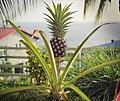Ananas: Difference between revisions
ClueBot NG (talk | contribs) m Reverting possible vandalism by 91.105.232.26 to version by 188.92.8.182. False positive? Report it. Thanks, ClueBot NG. (1413259) (Bot) |
No edit summary Tag: repeating characters |
||
| Line 1: | Line 1: | ||
BOUSSA Dance |
|||
{{italic title}} |
|||
{{Unreferenced|date=December 2009}} |
|||
{{For|the city and municipality in Tocantins state, [[Brazil]]|Ananás, Tocantins}} |
|||
Eeh |
|||
{{Taxobox |
|||
|name = ''Ananas'' |
|||
|image = Ananas.comosus1web.jpg |
|||
BOUSSA Dance |
|||
|image_caption = Pineapple (''Ananas comosus'') |
|||
|regnum = [[Plantae]] |
|||
|unranked_divisio = [[Angiosperms]] |
|||
DONT JEALOUS ME |
|||
|unranked_classis = [[Monocots]] |
|||
|unranked_ordo = [[Commelinids]] |
|||
- Tolulpae Adejetanobioluwatunday |
|||
|ordo = [[Poales]] |
|||
|familia = [[Bromeliaceae]] |
|||
|subfamilia = [[Bromelioideae]] |
|||
[[Abuja, Nigeria]] |
|||
|genus = '''''Ananas''''' |
|||
|genus_authority = [[Philip Miller|Mill.]] |
|||
|subdivision_ranks = Species |
|||
|subdivision = |
|||
*''[[Ananas ananassoides]]'' (Baker) [[Lyman Bradford Smith|L.B. Smith]] |
|||
*''[[Ananas bracteatus]]'' (Lindley) Schultes f. |
|||
*''[[Ananas comosus]]'' (Linnaeus) Merrill |
|||
Bos cos cos cos cos... |
|||
*''[[Ananas erectifolius]]'' |
|||
WAN TIN TIN!!! |
|||
BOUSSAAAAAA!! |
|||
[[Doussa]] |
|||
[[Democratic republic of the Congo]] |
|||
[[Senegal]] |
|||
{{senegal-stub}} |
|||
DEMAAAAAAAAAAAAA |
|||
*''[[Ananas fritzmuelleri]]'' Camargo |
*''[[Ananas fritzmuelleri]]'' Camargo |
||
*''[[Ananas lucidus]]'' Miller |
*''[[Ananas lucidus]]'' Miller |
||
Revision as of 18:04, 21 December 2012
BOUSSA Dance
Eeh
BOUSSA Dance
DONT JEALOUS ME
- Tolulpae Adejetanobioluwatunday
Bos cos cos cos cos...
WAN TIN TIN!!!
BOUSSAAAAAA!!
Democratic republic of the Congo
DEMAAAAAAAAAAAAA
- Ananas fritzmuelleri Camargo
- Ananas lucidus Miller
- Ananas nanus (L.B. Smith) L.B. Smith
- Ananas parguazensis Camargo & L.B. Smith
|}}
The genus Ananas belongs to the Bromeliad family (Bromeliaceae). It is best known for the species Ananas comosus, the pineapple.
This genus originated in Mesoamerica and was brought to the Caribbean Islands by the Carib natives. The oldest register with the representation of the fruit seems to be included in the Cascajal Block, attributed to the Olmec civilization.
In 1493, Christopher Columbus first saw plants of this genus in Guadeloupe. It was brought from Brazil to Europe by the Portuguese, and from there was distributed to the Pacific Islands by the Spanish and the English. Commercial pineapple plantations were established in Hawaii, the Philippines, Southeast Asia, Florida and Cuba. The pineapple has become one of the world's most popular fruits.
The tough leaves grow in large rosettes, arising basally from a crown. These leaves are long and lanceolate with a serrate or thorny margin. The flowers, arising from the heart of the rosette, each have their own sepals. They grow into a compact head on a short, robust stalk. The sepals become fleshy and juicy and develop into the well-known complex form of the pseudocarp fruit, crowned by a rosette of leaves.
Ananas species are used as food plants by the larvae of some Lepidoptera species including Batrachedra comosae, which feeds exclusively on A. comosus.
The word Ananas is derived from the Guarani name for the pineapple, via Portuguese. In many languages, pineapple is called "ananas".
Chemistry
Pineapples contain both bromelain and papain to which it owes its meat tenderizing properties.
Ethnobotanical Uses
The fruit and roots are used by some peoples as anti-inflammatory, proteolytic agent, and a root decoction for diarrhea. [citation needed]
Producments
The current (3.4.2012) biggest producment is USA (12,3 %), second is Thailand (11,4 %) and third are Philippines (10,9 %).
Species
- Ananas ananassoides (Baker) L.B. Smith
- Ananas bracteatus (Lindley) Schultes f.
- b. var. tricolor (Bertoni) L.B. Smith
- Ananas comosus (Linnaeus) Merrill
- b. var. variegatus (E. Lowe) Moldenke
- Ananas erectifolius
- Ananas fritzmuelleri Camargo
- Ananas lucidus Miller
- Ananas nanus (L.B. Smith) L.B. Smith
- Ananas parguazensis Camargo & L.B. Smith
Gallery
-
Pineapple plantation
-
Ananas bracteatus var. striatus
-
Fruit of Ananas bracteatus var. tricolor
-
Ananas nanus, habitat, Suriname
-
A pineapple in a garden in Martinique (Caribbean Sea)






